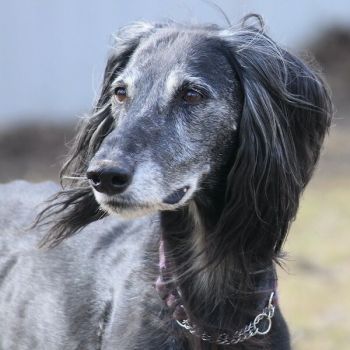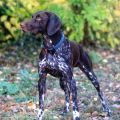Tazy (Kazakh sighthound) - to be published.
The Tazy, also known as the Kazakh sighthound, is a magnificent breed of dog that possesses a unique and captivating character. These dogs are native to Kazakhstan and have been bred for centuries for their exceptional hunting abilities. Not only are they skilled hunters, but they also make wonderful companions and family pets. Let's delve into the character of Tazy dogs, their behavior, and how to raise and train them.
Tazy dogs are known for their intelligence, loyalty, and independence. They have a strong prey drive and an innate instinct for hunting. This breed is primarily used for coursing game, such as hares and foxes, and their agility and speed are truly remarkable. Tazy dogs are medium-sized, with a lean and muscular build, enabling them to reach impressive speeds while chasing their prey.
In terms of behavior, Tazy dogs are generally calm and reserved. They are not overly aggressive or prone to unnecessary barking. However, their independent nature can sometimes make them appear aloof or distant. It is important to note that Tazy dogs are not typically recommended for first-time dog owners or those seeking a highly obedient breed. They require experienced handlers who understand their unique needs and characteristics.
When it comes to raising and training Tazy dogs, early socialization is crucial. Expose them to various people, animals, and environments from a young age to ensure they grow up to be well-rounded and adaptable dogs. Due to their independent nature, Tazy dogs may not always be eager to please their owners, making training a bit more challenging. Patience, consistency, and positive reinforcement techniques are key when training a Tazy.
It is important to provide Tazy dogs with regular mental and physical stimulation. Engage them in activities that cater to their natural instincts, such as lure coursing or agility training. These dogs thrive when they have a job to do, so providing them with tasks or challenges will keep them mentally stimulated and content.
Tazy dogs are generally good with children and can be affectionate towards their families. However, due to their hunting background, they may have a strong prey drive and may not be suitable for households with small pets, such as cats or rabbits. It is essential to supervise interactions between Tazy dogs and smaller animals to prevent any potential harm.
In terms of exercise, Tazy dogs require a significant amount of physical activity. They should have access to a securely fenced yard where they can run and play freely. Daily walks or jogs are also necessary to keep them physically fit and mentally satisfied. Lack of exercise can lead to restlessness and destructive behavior.
In conclusion, Tazy dogs are a remarkable breed with a distinct character. They are intelligent, loyal, and independent, making them excellent hunting companions and family pets. While they may require experienced handlers and consistent training, their unique traits and stunning appearance make them a cherished breed for those who appreciate their exceptional qualities.
The Tazy, also known as the Kazakh sighthound, is a magnificent breed originating from Kazakhstan. These elegant and athletic dogs require specific care to ensure their well-being and happiness. In this comprehensive guide, we will explore the recommended care for Tazy dogs, including tips on what to do and what not to do.
1. Exercise: Tazy dogs are highly active and require regular exercise to maintain their physical and mental health. Engage them in daily activities such as long walks, jogging, or playing fetch. However, avoid excessive exercise during their growth phase to prevent joint problems.
2. Fenced Yard: Tazy dogs have a strong prey drive and an incredible running ability. It is crucial to have a securely fenced yard to prevent them from chasing after small animals or escaping. Ensure the fence is at least six feet high and free from any gaps or weak spots.
3. Mental Stimulation: Alongside physical exercise, Tazy dogs need mental stimulation to prevent boredom and destructive behavior. Provide them with puzzle toys, interactive games, and obedience training sessions to keep their minds sharp and engaged.
4. Grooming: Tazy dogs have a short, dense coat that requires minimal grooming. Regular brushing with a soft bristle brush will help remove loose hair and keep their coat in good condition. Bathing should be done occasionally, only when necessary, to avoid stripping the natural oils from their skin.
5. Diet: A balanced and nutritious diet is essential for the overall health of Tazy dogs. Consult with a veterinarian to determine the appropriate portion sizes and choose high-quality dog food that meets their specific needs. Avoid overfeeding, as Tazys can be prone to obesity.
6. Socialization: Tazy dogs are known for their loyalty and affection towards their family. However, early socialization is crucial to ensure they are comfortable around strangers, children, and other animals. Expose them to various environments, people, and animals from a young age to promote positive interactions.
7. Health Care: Regular veterinary check-ups are vital to monitor the health of Tazy dogs. Vaccinations, deworming, and flea/tick prevention should be administered as recommended by the veterinarian. Additionally, be aware of breed-specific health issues such as hip dysplasia and heart conditions, and discuss preventive measures with your vet.
8. Temperature Regulation: Tazy dogs have a thin coat, making them sensitive to extreme temperatures. During hot weather, provide them with shade, fresh water, and avoid exercising them during the hottest parts of the day. In colder climates, consider providing them with a warm coat or sweater to keep them comfortable.
What NOT to do:
1. Do not leave a Tazy dog alone for extended periods. They thrive on companionship and may develop separation anxiety if left alone for too long.
2. Avoid using harsh training methods or punishment. Tazy dogs respond best to positive reinforcement techniques and gentle guidance.
3. Do not allow off-leash exercise in unfenced areas. Their strong prey drive may lead them to chase after small animals, potentially putting them in danger or causing harm to wildlife.
4. Avoid overfeeding or feeding them a diet that is not nutritionally balanced. Obesity can lead to various health issues and reduce their overall quality of life.
5. Do not neglect their mental stimulation needs. Without proper mental exercise, Tazy dogs may become bored and exhibit destructive behavior.
In conclusion, caring for a Tazy dog requires providing them with regular exercise, mental stimulation, a balanced diet, and proper socialization. By following these tips and avoiding common mistakes, you can ensure that your Tazy companion leads a happy, healthy, and fulfilling life.
The Tazy, also known as the Kazakh sighthound, is a magnificent breed of dog that possesses a unique and captivating coat color. These dogs are renowned for their elegance, grace, and striking appearance, which is further enhanced by their distinct coloration.
The common color of Tazy dogs can be described as a rich and lustrous shade of fawn. This warm hue exudes a sense of sophistication and adds to the overall allure of these magnificent creatures. The fawn color is characterized by its medium to dark intensity, resembling the color of a mature wheat field basking in the golden rays of the sun.
The coat of a Tazy dog is sleek, short, and dense, allowing the color to shine through with utmost brilliance. The fawn color is evenly distributed across the body, creating a harmonious and balanced appearance. The coat's texture is smooth to the touch, adding to the dog's regal demeanor.
When observing a Tazy, one cannot help but notice the subtle variations in the fawn color. Some individuals may exhibit a slightly lighter shade, reminiscent of the soft glow of sand dunes at dawn. Others may possess a deeper, more intense fawn color, akin to the rich tones of autumn leaves. These variations add depth and character to the overall coloration of the breed.
The fawn color of the Tazy extends beyond the coat, encompassing other features of the dog's anatomy. The eyes of these magnificent creatures are often adorned with a mesmerizing shade of amber or hazel, which beautifully complements their coat color. This combination creates a captivating contrast and further accentuates the dog's striking appearance.
In addition to the fawn coat color, Tazy dogs may also exhibit subtle markings or patterns. These markings can manifest as darker patches or stripes, often found on the face, ears, or along the back. These unique patterns add a touch of individuality to each Tazy, making them even more visually captivating.
The fawn color of the Tazy is not only aesthetically pleasing but also serves a practical purpose. These dogs were originally bred for hunting in the vast Kazakh steppes, where their coat color allowed them to blend seamlessly with their natural surroundings. This camouflage provided them with an advantage when pursuing prey, making them highly efficient hunters.
In conclusion, the common color of Tazy dogs can be described as a rich and lustrous fawn. This warm and captivating hue, combined with the sleek and dense coat, creates a visually stunning appearance. The subtle variations in the fawn color, along with any unique markings, add depth and individuality to each Tazy. Whether in the hunting fields or as a beloved companion, the Tazy's coloration is a testament to their beauty and grace.
Tazy dogs, also known as Kazakh sighthounds, are a breed native to Kazakhstan and are known for their exceptional speed and agility. These dogs have a unique set of health considerations that owners should be aware of to ensure their well-being. In this text, we will explore the most common diseases found in Tazy dogs and provide insights on how to care for their health.
One of the most prevalent health issues in Tazy dogs is hip dysplasia. This condition occurs when the hip joint doesn't develop properly, leading to discomfort, lameness, and even arthritis. To minimize the risk of hip dysplasia, it is crucial to obtain Tazy puppies from reputable breeders who conduct hip evaluations on their breeding stock. Additionally, maintaining a healthy weight and avoiding excessive exercise during the growing phase can help reduce the likelihood of this condition.
Another common health concern in Tazy dogs is bloat, also known as gastric dilatation-volvulus (GDV). This condition occurs when the stomach fills with gas and twists on itself, causing severe pain and potentially life-threatening consequences. To prevent bloat, it is recommended to feed Tazy dogs multiple small meals throughout the day instead of one large meal. Avoiding vigorous exercise immediately after meals and using elevated feeding bowls can also help reduce the risk.
Heart conditions, such as dilated cardiomyopathy (DCM), can also affect Tazy dogs. DCM is a disease that weakens the heart muscle, leading to poor heart function and potential heart failure. Regular veterinary check-ups, including cardiac evaluations, can help detect early signs of DCM. Additionally, providing a balanced diet rich in essential nutrients, including taurine, may contribute to heart health.
Like many sighthound breeds, Tazy dogs are prone to certain eye conditions. Progressive retinal atrophy (PRA) is a genetic disease that causes the degeneration of the retina, leading to progressive vision loss and eventual blindness. Regular eye examinations by a veterinary ophthalmologist can help identify PRA in its early stages. It is crucial to avoid breeding Tazy dogs with a history of PRA to prevent passing on this condition to future generations.
To ensure the overall health of Tazy dogs, regular exercise is essential. These dogs have a high energy level and require daily physical activity to prevent boredom and maintain their mental well-being. Providing a securely fenced area where they can run freely is ideal, as Tazy dogs have a strong prey drive and may chase small animals if not properly contained.
Proper nutrition is also crucial for the health of Tazy dogs. Feeding them a high-quality, balanced diet that meets their specific nutritional needs is essential. Consultation with a veterinarian can help determine the appropriate diet based on the dog's age, activity level, and any specific health concerns.
Regular veterinary care, including vaccinations, parasite prevention, and dental check-ups, is vital for the overall well-being of Tazy dogs. Routine examinations can help detect any potential health issues early on, allowing for prompt treatment and management.
In conclusion, Tazy dogs are a unique breed with specific health considerations. Hip dysplasia, bloat, heart conditions, and eye diseases are among the most common health issues in this breed. By obtaining Tazy puppies from reputable breeders, providing proper nutrition, regular exercise, and veterinary care, owners can ensure the optimal health and well-being of their beloved Tazy companions.
Tazy dogs, also known as Kazakh sighthounds, are a unique breed originating from Kazakhstan. These elegant and athletic dogs have specific nutritional needs to support their active lifestyle and maintain optimal health. Providing a well-balanced diet is crucial for Tazy dogs to thrive and prevent potential health issues. In this text, we will explore the nutrition requirements of Tazy dogs, offer advice on feeding them, and highlight foods to avoid.
Protein is an essential component of a Tazy dog's diet. It aids in muscle development, repair, and overall growth. High-quality animal-based proteins, such as lean meats (chicken, turkey, beef), fish, and eggs, should form the foundation of their diet. These protein sources provide essential amino acids that cannot be synthesized by the dog's body. It is recommended to feed Tazy dogs a diet consisting of at least 25-30% protein.
In addition to protein, Tazy dogs require a moderate amount of healthy fats. Fats are a concentrated source of energy and play a vital role in maintaining healthy skin and coat. Incorporating omega-3 fatty acids, found in fish oil or flaxseed oil, can help promote a glossy and lustrous coat. However, it is important to monitor fat intake to prevent obesity, as Tazy dogs have a tendency to gain weight if overfed.
Carbohydrates are another essential component of a Tazy dog's diet, providing energy for their active lifestyle. Opt for complex carbohydrates like whole grains (brown rice, oats) and vegetables (sweet potatoes, carrots). These sources offer a steady release of energy and are rich in fiber, aiding in digestion and preventing constipation. Avoid feeding excessive amounts of simple carbohydrates, such as refined grains and sugary treats, as they can lead to weight gain and potential health issues.
Vitamins and minerals are crucial for Tazy dogs' overall health and well-being. A balanced diet should include a variety of fruits and vegetables to provide essential vitamins and minerals. Leafy greens like spinach and kale, as well as fruits like blueberries and apples, are excellent choices. However, it is important to avoid feeding toxic foods like grapes, raisins, onions, and garlic, as they can be harmful to dogs.
Feeding Tazy dogs should be done in moderation, with portion control being key. Overfeeding can lead to obesity, which can strain their joints and increase the risk of various health problems. It is advisable to divide their daily food intake into two or three meals to prevent bloating and aid digestion. Consult with a veterinarian to determine the appropriate portion size based on your Tazy dog's age, weight, and activity level.
Water is often overlooked but is a vital component of a Tazy dog's nutrition. Ensure that fresh and clean water is always available to keep them hydrated, especially after exercise or during hot weather.
Lastly, it is important to avoid feeding Tazy dogs certain foods that can be toxic or harmful to their health. These include chocolate, caffeine, alcohol, avocado, and foods containing artificial sweeteners like xylitol.
In conclusion, providing a well-balanced diet is essential for the health and well-being of Tazy dogs. A diet rich in high-quality proteins, moderate in healthy fats, and supplemented with complex carbohydrates, vitamins, and minerals will support their active lifestyle. Remember to feed in moderation, provide fresh water, and avoid toxic foods. By following these guidelines, you can ensure that your Tazy dog remains healthy, energetic, and happy.





